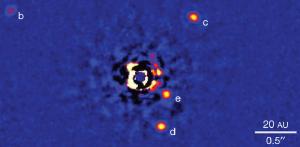Post
All These Worlds
15 March 2013
 B. R. Oppenheimer, et al.
B. R. Oppenheimer, et al.The first image below tells us something about the atmospheric makeup of four planets orbiting a star 130 light years away. Think on that for a bit. We’re now able to study the atmospheres of extra-solar planets. What’s even more amazing is it was done from a ground-based telescope.
 B. R. Oppenheimer, et al.
B. R. Oppenheimer, et al.The figure comes from a recent article in which a team of astronomers measured the absorption spectra of four planets planets of the star HR 8799.1 The image above shows these planets labeled b - e (HR 8799a is the star itself). As you might imagine, simply observing exoplanets directly is a challenge since the light from planets is overwhelmed by the light of the star. It helps that these are large Jupiter-like worlds, so they are relatively bright in the infrared, but the star is as well so it doesn’t help that much. So how was the team able to image not only the planets, but the spectra of those planets?
To pull this off, the team had to take long exposures of the star using a coronagraph. This is a device that blocks the direct light of the star, so you can measure light from other nearby sources such as the planets. Unfortunately you can’t block all the light from the star. Turbulence in the Earth’s atmosphere distorts the starlight we see, so you get a random pattern of scattered light in your image called speckle. With a long exposure and adaptive optics you can average out much of the speckle, but there is some speckle that occurs simply due to tiny flaws in your optics, and you can’t get rid of them. Since you can’t eliminate the defect speckle, you can’t be entirely sure what you are observing is a real planet or a flaw in your system.
But the position of the “defect speckle” depends on the wavelength of the light you are observing. So the team took long exposures at a range of wavelengths in the infrared. At each wavelength the speckle pattern is different, but the position of planet light stays the same. By combining the different wavelength images you can eliminate the speckle, leaving only the light from the planets, which is seen in the second image here. Once you know where the planets are, you can look at the light from those planets across the range of wavelengths you’ve observed, and thus get a spectrum for each planet.
In this infrared range, much of the light comes from the heat of the planets themselves. This means the spectra we observe is light that has passed from the planet through the planet’s atmosphere to reach us. Different gas molecules absorb light at different wavelengths, so by looking at a spectrum we can see at what wavelengths light is absorbed, which tells us what type of molecules are in the atmosphere.
The spectra gathered from these planets are pretty low resolution, so we can’t determine an exact makeup of the planetary atmospheres, but we can determine some broad characteristics. One interesting thing that was found is that these planets have very different atmospheres. For example, the atmosphere of planet b contains ammonia and carbon dioxide, but little methane. Planet e contains methane but not ammonia or carbon dioxide. This is rather surprising, since presumably large planets would tend to form early and therefore have similar makeups. How these planets can be radically different from each other is a bit of a puzzle.
But this is just the first of many planetary systems to be observed. The project, known as Project 1640 plans to observe about 200 nearby stars over a three year period using this method. So we’re likely to know about the atmospheres of a lot more extra-solar planets in the near future.
Oppenheimer, B. R., et al. “Reconnaissance of the HR 8799 exosolar system. I. Near-infrared spectroscopy.” The Astrophysical Journal 768.1 (2013): 24. ↩︎